Travelers Diarrhea India: What You Need to Know Before You Go
When you're exploring India's bustling markets, remote temples, or mountain trails, travelers diarrhea, a common stomach illness caused by contaminated food or water during travel. Also known as Montezuma's revenge, it's not a sign you did anything wrong—it's just part of the landscape for many visitors. It doesn’t mean you’re weak or careless. Even seasoned travelers get it. The good news? You can cut your risk way down with simple, smart choices.
Most cases come from Indian street food, popular, flavorful meals sold by vendors across cities and towns, especially if the water used to wash produce or ice in drinks isn’t clean. Food safety in India, the practices and standards that determine how safe meals are for tourists varies wildly—from spotless stalls in Delhi’s posh neighborhoods to dusty carts in rural Rajasthan. The same rule applies everywhere: if it’s cooked fresh, served hot, and peeled or washed in purified water, you’re in better shape. Avoid raw salads, unpeeled fruit, and ice unless you’re sure it’s made from bottled water. Bottled water isn’t foolproof—check the seal. Even brushing your teeth with tap water can be risky in some areas.
Travelers diarrhea isn’t just about what you eat. It’s also about your body adjusting. Your gut isn’t used to the local bacteria, and that shock can trigger symptoms like cramps, loose stools, and nausea. It usually lasts 3–5 days and clears on its own. But if you’re vomiting, running a fever, or seeing blood, don’t wait—seek help. Carry oral rehydration salts (they’re cheap and work fast) and maybe a short course of antibiotics like Rifaximin, just in case. Most pharmacies in tourist areas stock them without a prescription.
There’s a myth that you need to avoid Indian food entirely to stay safe. That’s not true. Thousands of travelers eat delicious, authentic meals every day without issue. The trick isn’t avoiding the food—it’s knowing how to pick the right spots. Busy stalls with high turnover mean fresher ingredients. Watch how the vendor handles money and food—do they wash their hands? Use gloves? If they’re juggling coins and then touching your food, walk away. Trust your nose. If something smells off, it probably is.
What you’ll find in the posts below isn’t just fear-mongering or vague warnings. It’s real, tested advice from people who’ve been sick, learned the hard way, and now know exactly how to enjoy India’s food without the aftermath. You’ll see which cities have safer street food scenes, what drinks are actually safe, how to spot clean vendors, and even what to pack in your first-aid kit. No fluff. No guesswork. Just what works.
